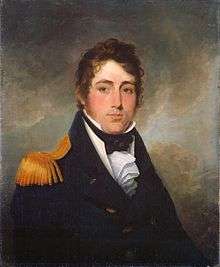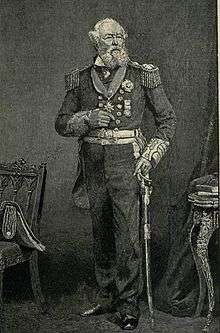Provo Wallis
| Sir Provo William Parry Wallis | |
|---|---|
 Wallis (1813) by Robert Field | |
| Born |
12 April 1791 Halifax, Nova Scotia |
| Died |
13 February 1892 (aged 100) Funtington, England |
| Allegiance |
|
| Service/branch |
|
| Years of service | 1795–1892 |
| Rank | Admiral of the Fleet |
| Commands held |
HMS Snipe HMS Niemen HMS Madagascar Senior Naval Officer, Gibraltar South East Coast of America Station |
| Battles/wars |
War of 1812 Pastry War |
| Awards | Knight Grand Cross of the Order of the Bath |
Admiral of the Fleet Sir Provo William Parry Wallis, GCB (12 April 1791 – 13 February 1892) was a Royal Navy officer. As a junior officer, following the capture of USS Chesapeake by the frigate HMS Shannon during the War of 1812, the wounding of HMS Shannon's captain and the death of her first lieutenant in the action, he served as the temporary captain of HMS Shannon for a period of exactly six days as she made her way back to Halifax, Nova Scotia, with Chesapeake flying the Blue Ensign above the Stars and Stripes.
As commanding officer of the fifth-rate HMS Madagascar, Wallis earned the thanks of the people of Veracruz in Mexico when he protected them from French bombardment during the Pastry War. He went on to be Senior Naval Officer, Gibraltar and then Commander-in-Chief on the South East Coast of America Station. He was 100 years old when he died.
Early career
.jpg)
Born the son of Provo Featherstone Wallis, a clerk at the Royal Navy's Halifax Naval Yard, and Elizabeth Wallis (née Lawlor),[1] Wallis benefited from his father's desire to secure a naval career for his son: knowing the rules for officers' entry into the navy, his father managed to get him officially registered in May 1795 as an able seaman on the 36-gun frigate HMS Oiseau at the age of four, by convincing her captain, Robert Murray to list him on the ship's books as an able seaman.[2] In May 1798 young Provo became a volunteer in the 40-gun frigate HMS Prévoyante where he remained (on paper at least) until September 1799 when he joined the 64-gun third-rate HMS Asia. He served on HMS Asia until September 1800, when he was promoted to midshipman in the 32-gun fifth-rate HMS Cleopatra.[3] HMS Cleopatra was the first ship he physically served aboard – he physically joined the ship in October 1804 – but by now he had amassed nearly a decade of seniority.[2] In an action on 16 February 1805, HMS Cleopatra was captured by the French frigate Ville de Milan and the ship's company taken prisoner of war. Wallis was freed a week later when the Ville de Milan was itself captured by the Royal Navy: he transferred to the Ville de Milan which now became a British ship.[3]
Wallis transferred to the third-rate HMS Triumph in November 1806 and to the third-rate HMS Bellona in February 1808 and, having been promoted to lieutenant on 13 November 1808, he transferred again to the sloop-of-war HMS Curieux later that month.[3] HMS Curieux ran aground and was wrecked on the coast of Guadeloupe in November 1809 and Wallis transferred to the fifth-rate HMS Gloire in December 1809.[4] He subsequently served in the sloops HMS Observateur, HMS Driver and HMS Emulous.[4]
Wallis transferred to the 38-gun frigate HMS Shannon in January 1812.[4] HMS Shannon captured the USS Chesapeake near Boston on 1 June 1813, during the War of 1812: HMS Shannon's Captain, Philip Broke, was badly wounded during the action and her first lieutenant was killed.[4] Wallis served as the temporary captain of the British frigate for a period of exactly six days as she made her way back to Halifax, Nova Scotia, with Chesapeake flying the Blue Ensign above the Stars and Stripes, for which action he was promoted to commander on 9 July 1813.[4]
Wallis was given command of the sloop HMS Snipe at Sheerness in January 1814.[4] Promoted to captain on 12 August 1819, he became commanding officer of the sixth-rate HMS Niemen at Halifax in June 1824 and commanding officer of the fifth-rate HMS Madagascar on the North America and West Indies Station in April 1838.[4] He earned the thanks of the people of Veracruz in Mexico when he protected then from French bombardment in Winter 1838 during the Pastry War.[4] Promoted to commodore, he went on to be Senior Naval Officer, Gibraltar, with his broad pennant of the third-rate HMS Warspite, in October 1843.[4]
Senior command

Promoted to rear-admiral on 27 August 1851,[5] Wallis became Commander-in-Chief, South East Coast of America Station, with his flag in the third-rate HMS Cumberland, in May 1857 but only held the command until September 1857.[4] He was promoted to vice-admiral on 10 September 1857,[6] appointed a Knight Commander of the Order of the Bath on 18 May 1860[7] and promoted to admiral on 2 March 1863.[8] He was appointed Rear-Admiral of the United Kingdom on 17 July 1869[9] and Vice-Admiral of the United Kingdom on 12 February 1870.[10]
In order to prevent admirals from dying as paupers, a special clause in the retirement scheme of 1870 provided that those officers who had commanded a ship before the end of the Napoleonic Wars should be retained on the active list: the few (6) days Wallis was in command of HMS Shannon qualified him to remain on the active list until he died.[2] He was advanced to Knight Grand Cross of the Order of the Bath on 24 May 1873[11] and promoted to Admiral of the Fleet on 11 December 1875.[12] The Admiralty suggested he retire when he reached his late nineties, as being on the active list meant he was liable for calling up for a seagoing command. Wallis instead replied he was ready to accept one.[2]
Wallis died at his country home in Funtington in West Sussex on 13 February 1892 and was buried in St Mary's church yard at Funtington.[4] He was only a few months short of his 101st birthday with a combined service from the time his name first appeared on the books of a Royal Navy Ship of 96 years.[2]
Family
In October 1817 Wallis married Juliana Massey; they had two daughters.[4] Following the death of his first wife, he married Jemima Wilson, daughter of Sir Robert Wilson, in 1849.[4]
Legacy
Wallis House in Ottawa is named after Wallis;[13] the City of Ottawa has erected brass plaques, which were unveiled in 1990 and 1997 documenting the history of the building.[14] The former Canadian Coast Guard Ship CCGS Provo Wallis was also named after him.[15]
See also
- O'Byrne, William Richard (1849). "
 Wallis, Provo William Parry".
Wallis, Provo William Parry".  A Naval Biographical Dictionary. John Murray. Wikisource.
A Naval Biographical Dictionary. John Murray. Wikisource.
References
- ↑ "Sir Provo Wallis". Dictionary of Canadian Biography. Retrieved 17 January 2015.
- 1 2 3 4 5 Ellis, p. 127-8
- 1 2 3 Heathcote, p. 248
- 1 2 3 4 5 6 7 8 9 10 11 12 13 Heathcote, p. 249
- ↑ The London Gazette: no. 21240. p. 2206. 29 August 1851. Retrieved 17 January 2015.
- ↑ The London Gazette: no. 22041. p. 3141. 18 September 1857. Retrieved 17 January 2015.
- ↑ The London Gazette: no. 22387. p. 1915. 18 May 1860. Retrieved 17 January 2015.
- ↑ The London Gazette: no. 22722. p. 1824. 31 March 1863. Retrieved 17 January 2015.
- ↑ The London Gazette: no. 23518. p. 4063. 20 July 1869. Retrieved 17 January 2015.
- ↑ The London Gazette: no. 23587. p. 851. 15 February 1870. Retrieved 17 January 2015.
- ↑ The London Gazette: no. 23979. p. 2583. 24 May 1873. Retrieved 17 January 2015.
- ↑ The London Gazette: no. 24278. p. 6577. 24 December 1875. Retrieved 17 January 2015.
- ↑ "Wallis House; Building housed seminary, barracks, public housing and hospital." Joanne Laucius. The Ottawa Citizen. Ottawa, Ontario: 7 May 1990. p. B.3.
- ↑ "Wallis House". National Inventory of Military Memorials. National Defence Canada. 17 January 2015.
- ↑ "Changes to Coast Guard's fleet". Canadian Coast Guard. Retrieved 17 January 2015.
Sources
- Ellis, James H. (2009). A Ruinous and Unhappy War: New England and the War of 1812. United States: Algora Publishing. ISBN 9780875866901.
- Heathcote, Tony (2002). The British Admirals of the Fleet 1734 – 1995. Pen & Sword. ISBN 0-85052-835-6.
Further reading
- Brighton, J.G. (1892). Admiral of the Fleet Sir Provo Wallis, G.C.B., 2 volumes. London.
External links
- Old Salt Indeed: The Amazing Career of Lieutenant Provo Wallis of HMS Shannon
- Provo Wallis Career History
| Military offices | ||
|---|---|---|
| Preceded by William Hope-Johnstone |
Commander-in-Chief, South East Coast of America Station May 1857– September 1857 |
Succeeded by Stephen Lushington |
| Honorary titles | ||
| Preceded by Sir Fairfax Moresby |
Rear-Admiral of the United Kingdom 1869–1870 |
Succeeded by Sir William Hope-Johnstone |
| Preceded by Sir Fairfax Moresby |
Vice-Admiral of the United Kingdom 1870–1876 |
Succeeded by Sir Michael Seymour |